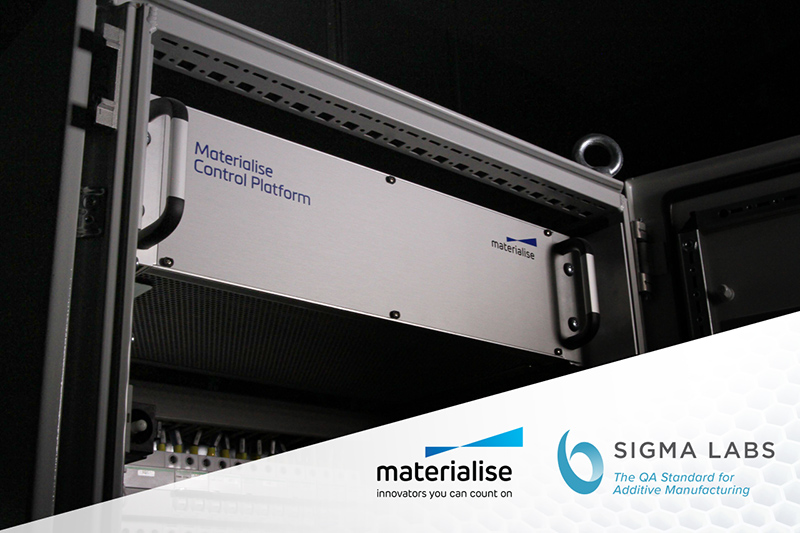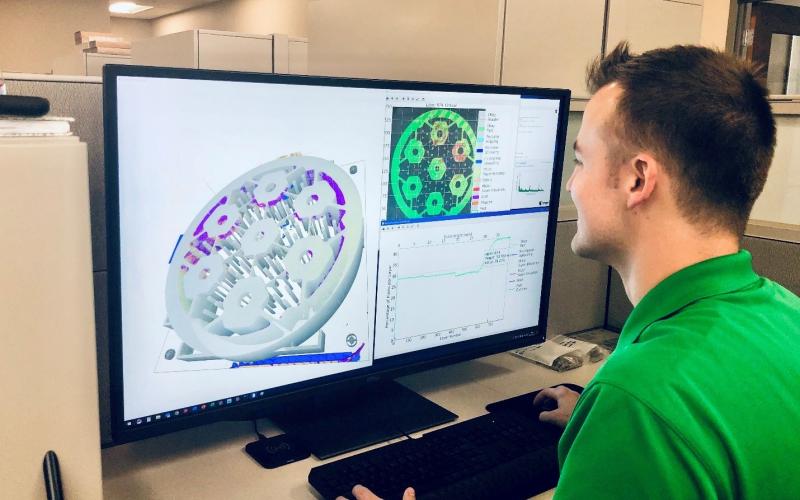Insiders and analysts have made their predictions on the 3D printing trends to watch out for. Find out more in our series focused on the future of 3D printing.
Quality assurance software developer Sigma Labs has partnered with 3D printing service provider Materialise to develop a technology that allows for the real-time correction of errors during metal additive manufacturing.
Effectively a combination of Sigma Labs’ PrintRite3D system and Materialise’s Control Platform, the setup is unique in that it allows users to identify and address issues that arise as alloy powders are fused together. Hailing the new platform as a “breakthrough” in metal 3D printing, Materialise says that it could now allow adopters to enhance the consistency and scalability of their workflows.
“The platform is open and flexible allowing manufacturers to take control of their specific processes to fit their unique applications,” explains Materialise CTO Bart van der Schueren. “This makes it possible for customers to leverage their expertise and truly take advantage of the customization and localization benefits that AM provides.”
“The platform we’ve developed eliminates one of the most common roadblocks for manufacturers interested in using metal additive manufacturing for serial production.”

Sigma Labs’ QA expertise
While Materialise has its fingers in many pies, with software, manufacturing and consultancy offerings, Sigma Labs focuses solely on quality assurance in production. Through its main product, PrintRite3D, the firm markets a solution made up of software and hardware tracking modules, that use real-time data to uncover part defects, before deploying machine learning to map their root causes.
Designed to be platform agnostic, the system can either be installed as a retrofit to an existing machine, or requested as a factory option from printer manufacturers. However, despite the broad compatibility and part defect analysis benefits of its main product offering, Sigma Labs’ revenue remains low, thus it continues to seek out new adopters and ways of addressing the wider 3D printing market.
In March last year, for instance, the company was awarded a contract by Lockheed Martin, which saw the viability of its technologies assessed for various defense and civil space programs, while on the R&D front, it has since made PrintRite3D polymer-compatible, in a move that has effectively expanded the system’s applications.
Now, after the unveiling of Sigma Labs and Materialise’s new platform, the firm’s CEO Mark Ruport says that the businesses can continue working together in future, to broaden both the scalability and appeal of metal 3D printing.
“We believe the combination of the Materialise Control Platform with Sigma’s real-time melt pool monitoring and analytics software, has created a significant breakthrough in the AM industry,” adds Ruport. “I look forward to future opportunities to collaborate and find ways to continue to improve the quality and consistency of 3D metal printing, as more companies go into production in the coming years.”

A metal 3D printing “breakthrough”
In order to create their new monitoring system, Sigma Labs and Materialise have essentially merged their respective PrintRite3D software and Control Platform hardware technologies together. The main component of the latter is basically an add-on, which can be embedded by users into laser-based machines, as a means of gaining enhanced print parameter control.
In its conventional guise, the technology allows adopters to access over 250 settings to identify the ideal production setup, while its architecture is built to work with up to 16-laser multi-optic systems. Said to be compatible with all PBF and SLM systems, Materialise’s platform also includes an automatic calibration tool API, that’s designed to enable users to easily maximize their manufacturing efficiency.
By combining this platform with Sigma Labs’ PrintRite3D technology, the companies have developed a means of pinpointing potential quality issues, and intervening to correct them before prints are spoiled beyond recovery. In doing so, Materialise says that the firms have come up with a way of improving metal 3D printing’s productivity and efficiency, that enables adopters to scale into serial production.
What’s more, the company believes that the new platform also has the potential to address the “need for post-build inspection and quality assurance” that can make metal 3D printing more expensive than many traditional technologies, especially given that it can either be installed on new machines or fitted to improve the print quality of existing systems.

Real-time metal printing monitoring
Although a number of real-time metal 3D printing monitoring solutions have been developed over the last few years, these have largely remained experimental, and not been applied within commercial settings. Late last year, a team at Lawrence Livermore National Laboratory came up with a novel high-speed videography-based approach to optimizing the metal material jetting process.
When it comes to monitoring powder-based systems, researchers at Oak Ridge National Laboratory have also developed an AI-based real-time tracking software. Known as ‘Peregrine,’ the algorithm is designed to assess the quality of parts during production, and serve as a potentially cost-effective alternative to pricey lab characterization equipment.
In the past, similar technologies have also attracted military backing, with metal 3D printing projects at the University of Texas at El Paso gaining US Army Research Lab funding, and more recently, Senvol’s machine learning software being awarded fresh investment by the US Department of Defense, to expand on its ‘ML’ platform’s additive manufacturing material and process qualification capabilities.
To stay up to date with the latest 3D printing news, don’t forget to subscribe to the 3D Printing Industry newsletter or follow us on Twitter or liking our page on Facebook.
For a deeper dive into additive manufacturing, you can now subscribe to our Youtube channel, featuring discussion, debriefs, and shots of 3D printing in-action.
Are you looking for a job in the additive manufacturing industry? Visit 3D Printing Jobs for a selection of roles in the industry.
Featured image shows a part being 3D printed while being monitored using Sigma’s PrintRite3D software. Photo via Sigma Labs.


